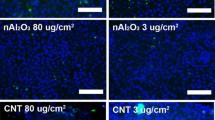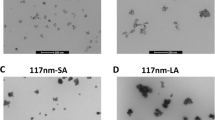Abstract
Among nanomaterials of industrial relevance, metal-based nanoparticles (NPs) are widely used, but their effects on airway cells are relatively poorly characterized. To compare the effects of metal NPs on cells representative of the lung-blood barrier, Calu-3 epithelial cells and Raw264.7 macrophages were incubated with three industrially relevant preparations of TiO2 NPs (size range 4–33 nm), two preparations of CeO2 NPs (9–36 nm) and CuO NPs (25 nm). While Raw264.7 were grown on standard plasticware, Calu-3 cells were seeded on permeable filters, where they form a high-resistance monolayer, providing an in vitro model of the airway barrier. Metal NPs, obtained from industrial sources, were characterized under the conditions adopted for the biological tests. Cytotoxicity was assessed with resazurin method in both epithelial and macrophage cells, while epithelial barrier permeability was monitored measuring the trans-epithelial electrical resistance (TEER). In macrophages, titania and ceria had no significant effect on viability in the whole range of nominal doses tested (15–240 μg/cm2 of monolayer), while CuO NPs produced a marked viability loss. Moreover, only CuO NPs, but not the other NPs, lowered TEER of Calu-3 monolayers, pointing to the impairment of the epithelial barrier. TEER decreased by 30 % at the dose of 10 μg/cm2 of CuO NPs, compared to untreated control, and was abolished at doses ≥80 μg/cm2, in strict correlation with changes in cell viability. These results indicate that (1) CuO NPs increase airway epithelium permeability even at relatively low doses and are significantly toxic for macrophages and airway epithelial cells, likely through the release of Cu ions in the medium; (2) TiO2 and CeO2 NPs do not affect TEER and exhibit little acute toxicity for airway epithelial cells and macrophages; and (3) TEER measurement can provide a simple method to assess the impairment of in vitro airway epithelial barrier model by manufactured nanomaterials.











Similar content being viewed by others
References
Brunauer S, Emmett PH, Teller E (1938) Adsorption of gases in multimolecular layers. J Am Chem Soc 60:309–319
Byrne F, Prina-Mello A, Whelan A, Mohamed BM, Davies A, Gun’ko YK, Coey JMD, Volkov Y (2009) High content analysis of the biocompatibility of nickel nanowires. J Magn Magn Mater 321:1341–1345
Celardo I, De Nicola M, Mandoli C, Pedersen JZ, Traversa E, Ghibelli L (2011) Ce(3)+ ions determine redox-dependent anti-apoptotic effect of cerium oxide nanoparticles. ACS Nano 5:4537–4549
Fenoglio I, Greco G, Livraghi S, Fubini B (2009) Non-UV-induced radical reactions at the surface of TiO2 nanoparticles that may trigger toxic responses. Chemistry 15:4614–4621
Finkbeiner WE, Carrier SD, Teresi CE (1993) Reverse transcription-polymerase chain reaction (RT-PCR) phenotypic analysis of cell cultures of human tracheal epithelium, tracheobronchial glands, and lung carcinomas. Am J Respir Cell Mol Biol 9:547–556
George S, Pokhrel S, Xia T, Gilbert B, Ji Z, Schowalter M, Rosenauer A, Damoiseaux R, Bradley KA, Madler L, Nel AE (2011) Use of a rapid cytotoxicity screening approach to engineer a safer zinc oxide nanoparticle through iron doping. ACS Nano 4:15–29
German RM, Park SJ (2008) Handbook of mathematical relations in particulate materials processing. Wiley, New York
Gunawan C, Teoh WY, Marquis CP, Amal R (2011) Cytotoxic origin of copper(II) oxide nanoparticles: comparative studies with micron-sized particles, leachate, and metal salts. ACS Nano 5:7214–7225
Hussain S, Boland S, Baeza-Squiban A, Hamel R, Thomassen LC, Martens JA, Billon-Galland MA, Fleury-Feith J, Moisan F, Pairon JC, Marano F (2009) Oxidative stress and proinflammatory effects of carbon black and titanium dioxide nanoparticles: role of particle surface area and internalized amount. Toxicology 260:142–149
IARC (2010) IARC monographs on the evaluation of carcinogenic risks to humans, vol 93. Carbon black, titanium dioxide, and talc. Lyon
Karlsson HL, Cronholm P, Gustafsson J, Moller L (2008) Copper oxide nanoparticles are highly toxic: a comparison between metal oxide nanoparticles and carbon nanotubes. Chem Res Toxicol 21:1726–1732
Kittaka S, Morimoto T (1980) Isoelectric point of metal oxides and binary metal oxides having spinel structure. J Colloid Interface Sci 75:398–403
Kroll A, Dierker C, Rommel C, Hahn D, Wohlleben W, Schulze-Isfort C, Gobbert C, Voetz M, Hardinghaus F, Schnekenburger J (2011) Cytotoxicity screening of 23 engineered nanomaterials using a test matrix of ten cell lines and three different assays. Part Fibre Toxicol 8:9
Lanone S, Rogerieux F, Geys J, Dupont A, Maillot-Marechal E, Boczkowski J, Lacroix G, Hoet P (2009) Comparative toxicity of 24 manufactured nanoparticles in human alveolar epithelial and macrophage cell lines. Part Fibre Toxicol 6:14
Lin W, Huang YW, Zhou XD, Ma Y (2006) Toxicity of cerium oxide nanoparticles in human lung cancer cells. Int J Toxicol 25:451–457
Liu R, Zhang X, Pu Y, Yin L, Li Y, Liang G, Li X, Zhang J (2011) Small-sized titanium dioxide nanoparticles mediate immune toxicity in rat pulmonary alveolar macrophages in vivo. J Nanosci Nanotechnol 10:5161–5169
Long TC, Saleh N, Tilton RD, Lowry GV, Veronesi B (2006) Titanium dioxide (P25) produces reactive oxygen species in immortalized brain microglia (BV2): implications for nanoparticle neurotoxicity. Environ Sci Technol 40:4346–4352
Ma JY, Zhao H, Mercer RR, Barger M, Rao M, Meighan T, Schwegler-Berry D, Castranova V, Ma JK (2011) Cerium oxide nanoparticle-induced pulmonary inflammation and alveolar macrophage functional change in rats. Nanotoxicology 5:312–325
Malugin A, Herd H, Ghandehari H (2011) Differential toxicity of amorphous silica nanoparticles toward phagocytic and epithelial cells. J Nanopart Res. doi:10.1007/s11051-011-0524-7
Mao JA, Bai Y, Gu L, van Aken PA, Tu MJ (2010) Preparation and characterization of size-controlled CeO(2) nanoparticles coated with SiO(2). J Nanopart Res 12:2045–2049
Nel AE, Madler L, Velegol D, Xia T, Hoek EM, Somasundaran P, Klaessig F, Castranova V, Thompson M (2009) Understanding biophysicochemical interactions at the nano-bio interface. Nat Mater 8:543–557
NIOSH Department of Health and Human Services—Centers for Disease Control and Prevention (2011) Occupational exposure to titanium dioxide. Curr Intell Bull:63
O’Brien RW, Cannon DW, Rowlands WN (1995) Electroacoustic determination of particle-size and zeta-potential. J Colloid Interface Sci 173:406–418
O’Brien J, Wilson I, Orton T, Pognan F (2000) Investigation of the Alamar Blue (resazurin) fluorescent dye for the assessment of mammalian cell cytotoxicity. Eur J Biochem 267:5421–5426
Poland CA, Byrne F, Cho WS, Prina-Mello A, Murphy FA, Davies GL, Coey JM, Gounko Y, Duffin R, Volkov Y, Donaldson K (2011) Length-dependent pathogenic effects of nickel nanowires in the lungs and the peritoneal cavity. Nanotoxicology. doi:10.3109/17435390.2011.626535
Rotoli BM, Bussolati O, Bianchi MG, Barilli A, Balasubramanian C, Bellucci S, Bergamaschi E (2008) Non-functionalized multi-walled carbon nanotubes alter the paracellular permeability of human airway epithelial cells. Toxicol Lett 178:95–102
Rotoli BM, Bussolati O, Barilli A, Zanello PP, Bianchi MG, Magrini A, Pietroiusti A, Bergamaschi A, Bergamaschi E (2009) Airway barrier dysfunction induced by exposure to carbon nanotubes in vitro: which role for fiber length? Hum Exp Toxicol 28:361–368
Rzigalinski BA, Meehan K, Davis RM, Xu Y, Miles WC, Cohen CA (2006) Radical nanomedicine. Nanomedicine (Lond) 1:399–412
Salem LB, Bosquillon C, Dailey LA, Delattre L, Martin GP, Evrard B, Forbes B (2009) Sparing methylation of beta-cyclodextrin mitigates cytotoxicity and permeability induction in respiratory epithelial cell layers in vitro. J Control Release 136:110–116
Sayes CM, Reed KL, Warheit DB (2007) Assessing toxicity of fine and nanoparticles: comparing in vitro measurements to in vivo pulmonary toxicity profiles. Toxicol Sci 97:163–180
Singh S, Shi T, Duffin R, Albrecht C, van Berlo D, Hohr D, Fubini B, Martra G, Fenoglio I, Borm PJ, Schins RP (2007) Endocytosis, oxidative stress and IL-8 expression in human lung epithelial cells upon treatment with fine and ultrafine TiO2: role of the specific surface area and of surface methylation of the particles. Toxicol Appl Pharmacol 222:141–151
Soto K, Garza KM, Murr LE (2007) Cytotoxic effects of aggregated nanomaterials. Acta Biomater 3:351–358
Studer AM, Limbach LK, Van Duc L, Krumeich F, Athanassiou EK, Gerber LC, Moch H, Stark WJ (2010) Nanoparticle cytotoxicity depends on intracellular solubility: comparison of stabilized copper metal and degradable copper oxide nanoparticles. Toxicol Lett 197:169–174
Suttiponparnit K, Jiang J, Sahul M, Suvachittanont S, Charinpanitkul T, Biswa P (2011) Role of surface area, primary particle size, and crystal phase on titanium dioxide nanoparticle dispersion properties. Nanoscale Res Lett 6:441. doi:410.1007/s11671-11010-19772-11671
Xia T, Kovochich M, Liong M, Madler L, Gilbert B, Shi H, Yeh JI, Zink JI, Nel AE (2008) Comparison of the mechanism of toxicity of zinc oxide and cerium oxide nanoparticles based on dissolution and oxidative stress properties. ACS Nano 2:2121–2134
Acknowledgments
Supported by the EU-funded research project ‘Safe Nano Worker Exposure Scenarios’—SANOWORK (Grant No. FP7-280716). We thank Mr. Paul Reip (Intrinsiq Materials Ltd., Cody Technology Park, Ively Road, Farnborough—Hampshire, UK) and Prof. Lucia Migliore, University of Pisa, for CuO NPs.
Author information
Authors and Affiliations
Corresponding author
Additional information
Special Issue Editors: Candace S.-J. Tsai, Michael J. Ellenbecker
This article is part of the topical collection on Nanotechnology, Occupational and Environmental Health
Electronic supplementary material
Below is the link to the electronic supplementary material.
Rights and permissions
About this article
Cite this article
Rotoli, B.M., Bussolati, O., Costa, A.L. et al. Comparative effects of metal oxide nanoparticles on human airway epithelial cells and macrophages. J Nanopart Res 14, 1069 (2012). https://doi.org/10.1007/s11051-012-1069-0
Received:
Accepted:
Published:
DOI: https://doi.org/10.1007/s11051-012-1069-0




